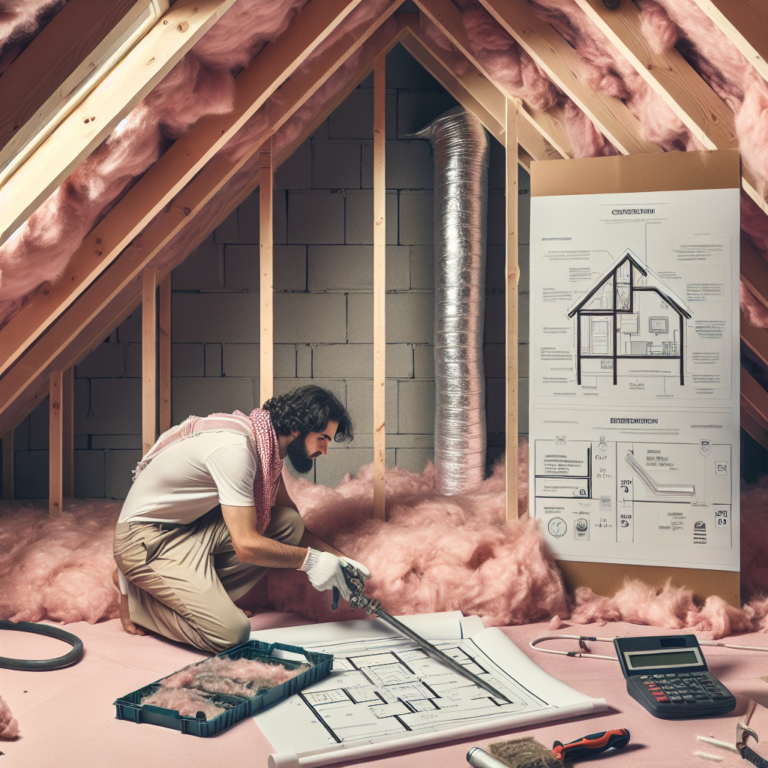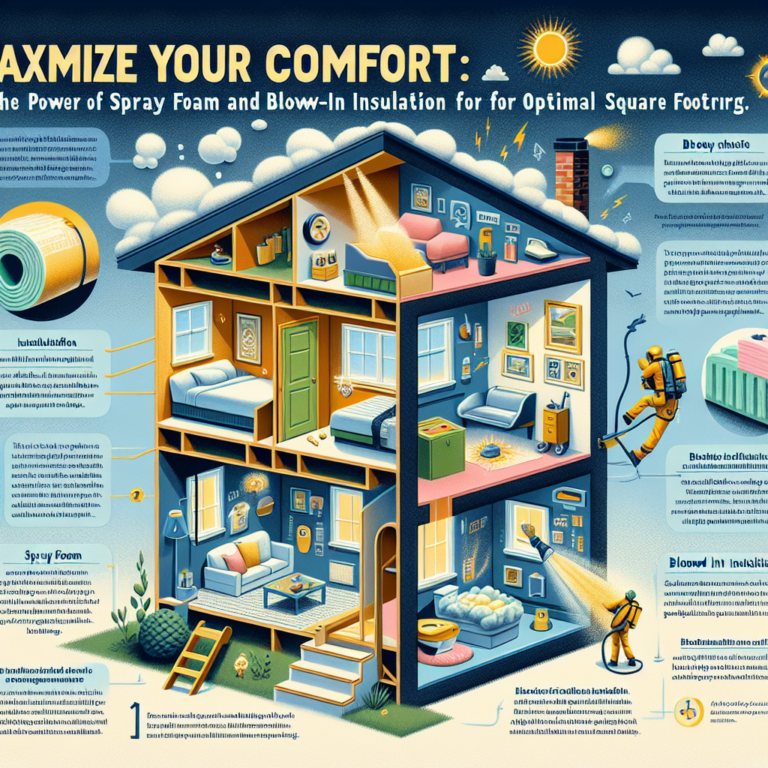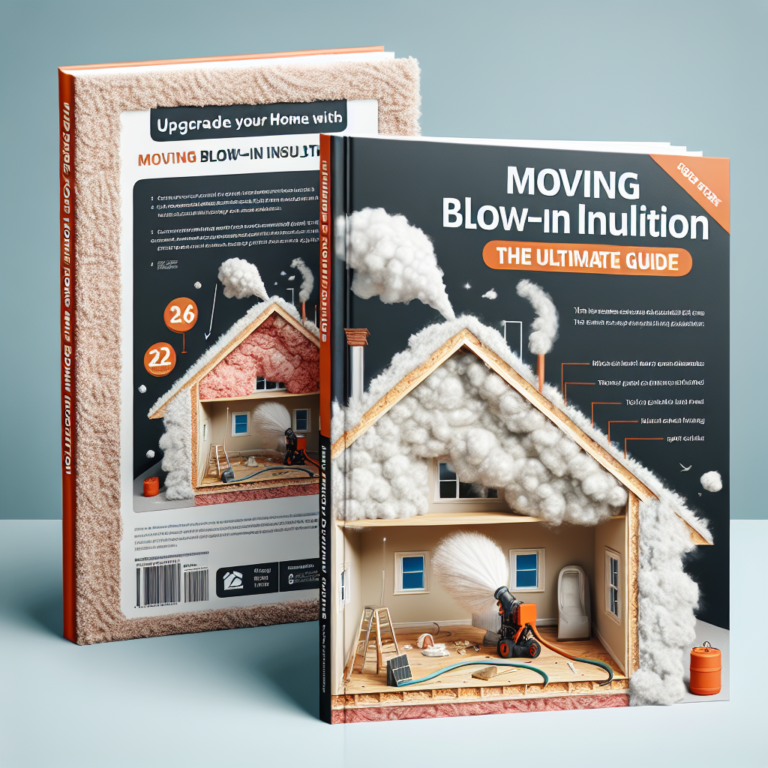-
Table of Contents
“Efficiently insulate your home with R-49 blown in insulation – keeping you warm and saving you money!”
Introduction
Blown-in insulation is a type of insulation that is installed by blowing loose fibers or particles into an enclosed space, such as an attic or wall cavity. This method of insulation is often used to fill in gaps and crevices, providing a more complete and efficient coverage compared to traditional batt insulation. It is a popular choice for homeowners looking to improve the energy efficiency of their homes and reduce heating and cooling costs. In this article, we will explore the benefits and installation process of blown-in insulation.
Benefits of Fiberglass Blown In Insulation for Your Home
Fiberglass blown in insulation is a popular choice for homeowners looking to improve the energy efficiency of their homes. This type of insulation is made from tiny glass fibers that are blown into the walls, attic, or other areas of the home using specialized equipment. It is a cost-effective and efficient way to insulate your home, providing numerous benefits that make it a top choice for many homeowners.
One of the main benefits of fiberglass blown in insulation is its ability to reduce energy costs. By creating a barrier between the inside and outside of your home, this type of insulation helps to keep the temperature inside your home consistent. This means that your heating and cooling systems don’t have to work as hard to maintain a comfortable temperature, resulting in lower energy bills. In fact, studies have shown that homes with proper insulation can save up to 20% on their energy costs.
In addition to saving money on energy bills, fiberglass blown in insulation also helps to reduce your carbon footprint. By using less energy to heat and cool your home, you are also reducing the amount of greenhouse gases that are emitted into the environment. This is not only beneficial for the planet, but it can also make you feel good about doing your part to protect the environment.
Another advantage of fiberglass blown in insulation is its ability to improve the overall comfort of your home. By creating a more consistent temperature, this type of insulation helps to eliminate cold spots and drafts, making your home more comfortable year-round. This is especially beneficial during the winter months when cold air can seep in through poorly insulated walls and attics. With fiberglass blown in insulation, you can enjoy a cozy and comfortable home without having to constantly adjust the thermostat.
Furthermore, fiberglass blown in insulation is a great choice for homeowners looking to reduce noise levels in their homes. The tiny glass fibers used in this type of insulation help to absorb sound, making your home quieter and more peaceful. This is particularly beneficial for homes located in noisy areas or for those who have loud neighbors. With fiberglass blown in insulation, you can enjoy a quieter and more peaceful living space.
One of the most significant benefits of fiberglass blown in insulation is its durability. Unlike other types of insulation, such as foam or cellulose, fiberglass does not settle or compress over time. This means that it will maintain its effectiveness for many years, providing long-term energy savings and comfort for your home. Additionally, fiberglass is resistant to mold and mildew, making it a healthier choice for your home.
Lastly, fiberglass blown in insulation is a relatively quick and easy installation process. Unlike traditional insulation methods, which can be time-consuming and messy, this type of insulation can be installed in a matter of hours. This means minimal disruption to your daily routine and less hassle for you as a homeowner.
In conclusion, fiberglass blown in insulation offers numerous benefits for homeowners looking to improve the energy efficiency, comfort, and overall value of their homes. From reducing energy costs and carbon footprint to improving comfort and reducing noise levels, this type of insulation is a smart investment for any homeowner. With its durability and easy installation process, it is a cost-effective and efficient way to make your home more energy-efficient and comfortable. Consider fiberglass blown in insulation for your home and start reaping the benefits today.
How to Install Fiberglass Blown In Insulation from Home Depot

Fiberglass blown in insulation is a popular and effective way to insulate your home. It is a cost-effective and energy-efficient solution that can help reduce your heating and cooling costs. If you are considering installing fiberglass blown in insulation in your home, Home Depot offers a wide range of options to choose from. In this article, we will guide you through the process of installing fiberglass blown in insulation from Home Depot.
Before you begin the installation process, it is important to understand the benefits of fiberglass blown in insulation. This type of insulation is made of tiny glass fibers that are blown into the walls, floors, and ceilings of your home. These fibers create a barrier that helps to trap air and prevent heat from escaping, keeping your home warm in the winter and cool in the summer. Additionally, fiberglass blown in insulation is non-combustible, making it a safe choice for your home.
The first step in installing fiberglass blown in insulation is to gather all the necessary materials. Home Depot offers a variety of insulation options, including different R-values, which measure the insulation’s ability to resist heat flow. The higher the R-value, the more effective the insulation will be. It is important to choose the right R-value for your home based on its location and climate.
Once you have chosen the right insulation for your home, it is time to prepare the area for installation. Make sure to wear protective gear, such as gloves, goggles, and a mask, as fiberglass can irritate the skin and lungs. Clear the area of any obstacles and cover any electrical outlets or fixtures with plastic sheeting to prevent insulation from getting inside.
Next, you will need to prepare the insulation machine. Home Depot offers a rental service for insulation machines, which can be picked up at your local store. The machine will come with instructions on how to set it up and operate it. It is important to follow these instructions carefully to ensure a smooth installation process.
Once the machine is set up, it is time to start blowing in the insulation. Begin at the farthest corner of the area and work your way towards the exit. Hold the hose of the machine about 12 inches away from the wall and start blowing the insulation into the cavity. Make sure to fill the cavity evenly and avoid overstuffing it, as this can reduce the insulation’s effectiveness.
As you work your way towards the exit, make sure to cover all the areas evenly. It is important to maintain a consistent depth of insulation throughout the area. You can use a ruler or measuring tape to ensure that the insulation is evenly distributed.
Once you have finished blowing in the insulation, it is time to clean up. Use a broom or vacuum to remove any excess insulation from the floor and walls. Make sure to dispose of the used insulation properly, as it can be a health hazard if not handled correctly.
In conclusion, installing fiberglass blown in insulation from Home Depot is a simple and effective way to insulate your home. By following these steps and using the right materials, you can improve your home’s energy efficiency and save money on heating and cooling costs. Remember to always wear protective gear and follow the instructions carefully for a successful installation. With Home Depot’s wide range of insulation options and rental services, you can easily make your home more comfortable and energy-efficient.
Comparing Fiberglass Blown In Insulation to Other Types of Insulation
Insulation is an essential component of any building, whether it is a residential home or a commercial space. It helps to regulate the temperature inside, keeping it warm in the winter and cool in the summer. With the rising costs of energy, having proper insulation is crucial in reducing energy consumption and saving money on utility bills. One type of insulation that has gained popularity in recent years is fiberglass blown in insulation. In this article, we will compare fiberglass blown in insulation to other types of insulation and explore its benefits.
Fiberglass blown in insulation is made up of tiny glass fibers that are blown into the walls, attics, and crawl spaces of a building. It is a loose-fill insulation, meaning it is not pre-cut into specific sizes and shapes like other types of insulation. This allows it to fill in any gaps and crevices, providing a more comprehensive coverage and better insulation. Other types of insulation, such as batt insulation, come in pre-cut sheets that may not fit perfectly in irregular spaces, leaving room for air leaks and reducing its effectiveness.
One of the main advantages of fiberglass blown in insulation is its ability to provide a high R-value. R-value is a measure of an insulation material’s resistance to heat flow. The higher the R-value, the better the insulation. Fiberglass blown in insulation has an R-value of 3.2 to 3.8 per inch, making it one of the most efficient insulation materials on the market. This means that it can effectively reduce heat transfer and keep the building’s interior temperature stable.
Another benefit of fiberglass blown in insulation is its cost-effectiveness. It is relatively inexpensive compared to other types of insulation, such as spray foam or cellulose. This makes it a popular choice for homeowners and builders looking for a budget-friendly insulation option. Additionally, its installation process is quick and easy, which can save on labor costs.
One of the most significant advantages of fiberglass blown in insulation is its fire resistance. Unlike other types of insulation, such as cellulose, which is made from recycled paper, fiberglass is non-combustible. This means that it will not catch fire or contribute to the spread of flames in case of a fire. This makes it a safer option for buildings, especially those in high-risk fire areas.
Compared to other types of insulation, fiberglass blown in insulation is also more environmentally friendly. It is made from recycled glass, making it a sustainable option for insulation. Additionally, it does not contain any harmful chemicals or emit any volatile organic compounds (VOCs), making it safe for both the environment and human health.
While fiberglass blown in insulation has many benefits, it also has some limitations. One of the main drawbacks is its susceptibility to moisture. If not installed correctly, it can absorb moisture, leading to mold and mildew growth. This can reduce its effectiveness and pose health risks to the building’s occupants. However, with proper installation and regular maintenance, this can be avoided.
In conclusion, fiberglass blown in insulation is a cost-effective, efficient, and environmentally friendly option for insulation. Its high R-value, fire resistance, and ease of installation make it a popular choice among homeowners and builders. However, it is essential to ensure proper installation and maintenance to avoid any potential issues. Overall, fiberglass blown in insulation is a reliable and effective choice for insulating any building.
Q&A
1. What is R-49 blown in insulation?
R-49 blown in insulation is a type of insulation material that is blown into attics or walls to provide thermal resistance and improve energy efficiency in buildings. It has an R-value of 49, which is a measure of its ability to resist heat flow.
2. How is R-49 blown in insulation installed?
R-49 blown in insulation is installed using a special machine that blows the insulation material into the desired area. The insulation is typically made of fiberglass, cellulose, or mineral wool and is blown in until it reaches the desired thickness and coverage.
3. What are the benefits of using R-49 blown in insulation?
R-49 blown in insulation offers several benefits, including improved energy efficiency, reduced heating and cooling costs, and increased comfort in the building. It also helps to reduce noise transmission and can improve indoor air quality by reducing drafts and air leaks. Additionally, it is a cost-effective and environmentally friendly option for insulating buildings.
Conclusion
In conclusion, blown-in insulation, also known as loose-fill insulation, is a popular and effective method of insulating homes and buildings. It involves using a machine to blow small particles of insulation material, such as fiberglass, cellulose, or mineral wool, into the walls, attic, or other areas of a structure. This method is often preferred over traditional batt insulation because it can easily fill in small gaps and crevices, providing better coverage and reducing air leakage. Additionally, blown-in insulation is a cost-effective option and can help improve energy efficiency and reduce heating and cooling costs. Overall, blown-in insulation is a great choice for homeowners and builders looking to improve the insulation and energy efficiency of their properties.




